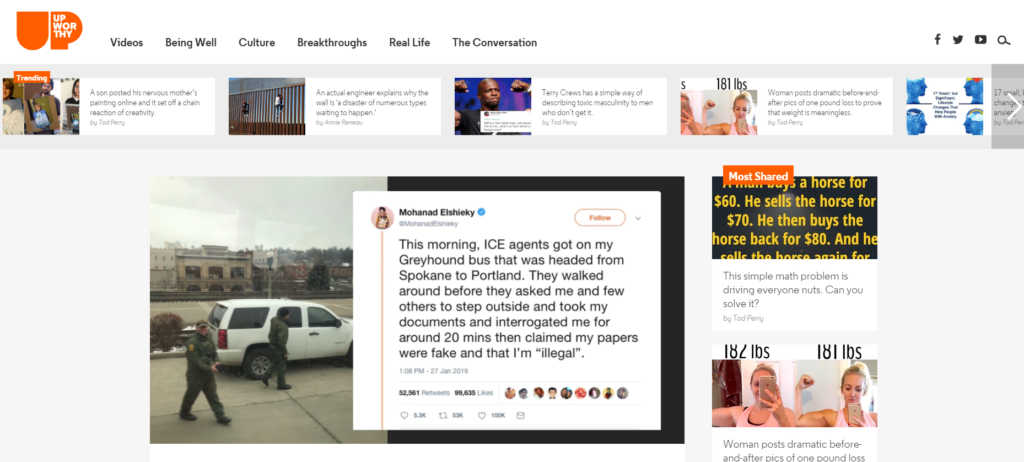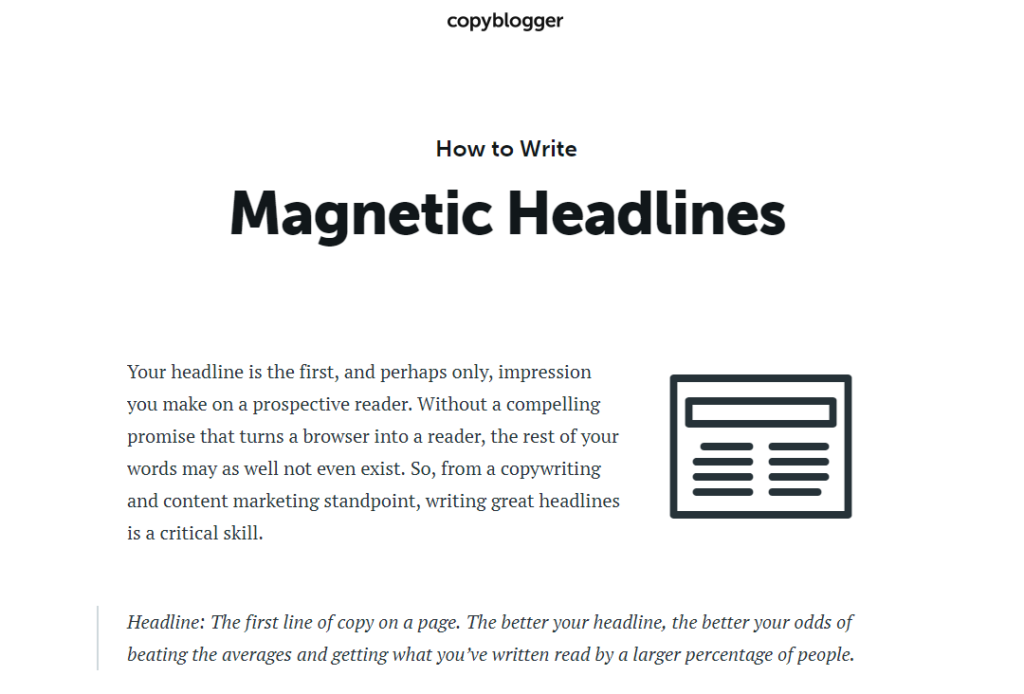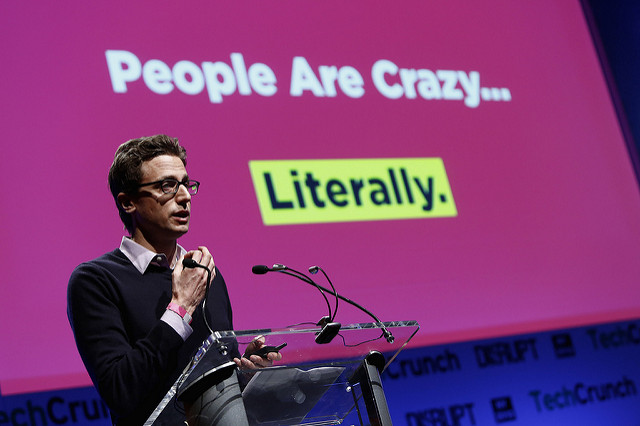What can
Those paying close attention might crack the code to writing web content that’s designed to spread at scale.
Last week, Buzzfeed announced a set of layoffs, leaving 200 staff jobless.
They weren’t the first internet news company to start faltering.
Upworthy attracted hundreds of millions each month with its blend of viral content and unique brand of headlines. Last year, 31 Upworthy staff lost their jobs, and the CEO and editor-in-chief resigned shortly after.
Both BuzzFeed and Upworthy were casualties of the dominance of Facebook and Google. The two internet giants amassed over $60 billion in ad revenue in 2018.
An analysis of the decline of internet publishers like BuzzFeed and Upworthy – who seemed to have mastered the modern digital media industry – underscores the complete control Facebook and Google now wield over online advertising.
Although new media companies are battling to gain ground in a market owned by a duopoly, their editorial strategies are stunning case studies for creating content that connects with online audiences.
In this post, I’ll highlight the areas they did well, and how content writers can employ some of these tactics in their own content creation.
First Impressions Matter: Writing Effective Headlines
Let’s start with the most obvious thing. BuzzFeed and Upworthy get you to pause mid-scroll with headlines than command a click.
In this piece on Overit.com, Lisa Barone said studying BuzzFeed is a “virtual headline-writing training course”.
Here are a few that were trending on Upworthy at the time of writing this article:
- Woman posts dramatic before-and-after pics of one pound loss to prove that weight is meaningless
- This simple math problem is driving everyone nuts. Can you solve it?
- How practicing kindness can make your life so much better.

Landing on the right headline isn’t a matter of chance. The team at Upworthy were obsessed with finding seductive headlines: it was a deliberate act of persuasion.
In this piece from Gizmodo, Molly Osberg describes Upworthy’s system:
“…Upworthy popularized the “curiosity gap” headline: Basically, a headline that over-promises emotionally (“These words were meant to break these women”) while revealing almost nothing about a story’s content (“But the opposite happened.”) The idea here was that a person’s knee-jerk desire would compel them to click headlines that were the right combination of tantalizing and vague, which they pretty uniformly did.
“Such headlines were introduced largely through Upworthty’s Facebook testing process:“Curators” wrote 25 headlines for every video they wanted to post, and then deployed combinations of images and text to a small batch of test subjects before posting whichever combination they clicked and shared the most.”
The result?
Within a year, Upworthy was getting 100 million users each month. Traditional media houses wanted some of the secret sauce, and soon Upworthy staff were consulting with the New York Times, The Atlantic, CNN and Time.
While you might scoff at the headlines, the important thing here is that Upworthy took the time to design a process. They tested constantly and found patterns that resonated with test audiences.
Takeaways and Tools
I worked in a print newsroom for close to a decade, but writing headlines for the web is a different story. Good thing is, you get better with practice.
There’s a ton of resources online if you’re just getting started:
- Copyblogger has a PDF on writing Magnetic Headlines. This might be a good starting point.

- You can test your headline’s with free tools like the CoSchedule Headline Analyzer.
- The Advanced Marketing Institute’s Emotional Marketing Value Headline Analyzer will score your headline, and suggest which emotions it will elicit from your reader.
Dive Into Data to Write Web Content People Want to Read
Is there anything sexier than data right now?
Everywhere we look important people are telling us to use data.
It’s going to shape the world.
It will be the only asset we need to connect with distracted audiences in the attention economy.
And I don’t think this is hype. We live in the digital age, you can now access public data to help make personal decisions. But sometimes I’m worried the term “data-driven” will go the way of “disruptive technologies” – an annoying corporate buzzword that hides the true usefulness.
And if there was ever a test case for the value of data for content, it’s Buzzfeed.
I’m fascinated by the sophisticated machinery that powers Buzzfeed’s data collection.
In this Vanity Fair piece, we learn more about Jonah Peretti, the founder of BuzzFeed. Turns out he got his start – and millions – from his time at the Huffington Post. As a co-founder at HuffPost, Peretti knew how to get the content to rank, driving substantial traffic to the site. Peretti pocketed millions when HuffPost was
A former computing teacher, Peretti studied the science of virology at the M.I.T media lab and when he applied his learnings to the business of internet news BuzzFeed became unstoppable.

Peeping under the hood reveals a close study of networks that lets BuzzFeed explore how ideas move through social media.
Fast Company writer, Noah Robischon, spent a month with Peretti and his team and recounts his experience here.
Describing Peretti as “one of the most astute observers of Internet
“.. BuzzFeed is a continuous feedback loop where all of its articles and videos are the input for its sophisticated data operation, which then informs how BuzzFeed creates and distributes the advertising it produces.”
In Robischon’s piece, Peretti explains how he plans to tap into the power of data: “If we actually learn what works on Snapchat, Instagram, Twitter, YouTube, and Facebook …and we actually learn what works in Brazil and the U.K., and we can figure out a way of sharing that knowledge, we should have a better understanding of how to make great content that people love.”
To harness these insights, BuzzFeed employs the science made possible by Pound, an initiative designed to show how people share content on different social networks. The programme uses nine different metrics, to document the flow of content. They’re able to make predictions on the speed of dissemination based on where it’s first released.

Pound is part of Hive – the mothership of BuzzFeed’s data operation.
Hive will let BuzzFeed know the performance of each type of content; how it spreads from one social network to another, how pieces of content relate.
“If a writer is going to do a post about pizza, Peretti says, “you should see all the things that the audiences have loved about pizza, you should see what people have done before,” he explains, “then build on top of that.”, writes Robischon.
Robischon also shared some of the interviews he conducted with Dao Nguyen, BuzzFeed’s publisher.
I love Nguyen’s approach – blending the science of data and the magic of
You have to use a lot of intuition and a lot of creativity, and the data is one part of the input you take in to think about why this could do well, why do people share it. The data never tells you why anything happens. Data will tell you, if you’re very lucky, what happened. It won’t ever tell you why. If you want to understand why, that requires a different set of skills, largely in your brain and in your heart. Why did this story resonate with people?
Nguyen refers to comments on things like YouTube videos, as a form of data you can immediately use to gain an understanding of how a particular piece of content is performing.
Takeways and Tools
You don’t need a BuzzFeed budget to harness the power of data.
Here’s a few tips and tools:
- Read comments on blog posts and social media posts to assess how people respond to content.
- Use free tools like Facebook Audience Insights.
- Get your data geek on with an application like NodeXL. NodeXL is a free open-source template that lets you identify and
visualise the connections between nodes (users). I’ve only used it with Twitter data, and it’s great to see how posts spread.There’s free video tutorials if you get stuck. but the learning curve isn’t too steep.
And most importantly, don’t be blinded by the data. We’re not robots and we don’t have to behave like them. By simply being human, we can deduce why an article performed well.
Facebook is not Your Friend
Google’s included in my implication, but … alliteration.
Here’s the thing. We’re at the mercy of Facebook’s next News Feed update, or Google’s new cute-animal algorithm. (I’m saying this as a bit of a Google-stan)
Facebook’s head of news allegedly told media executives he’d be “holding your hands with your dying business like in a hospice.”
Following a change in Facebook’s News Feed, which prioritised posts from family and friends over publishers, Upworthy’s traffic dropped from 90 million to 48 million over just two months.
Facebook and Google are businesses. They want to make as much revenue as possible. Sometimes that will work for us, but that’s a byproduct of whether the tactic meets their business goals – not ours.
And the other times, their tweaks do provide a better experience for the reader. For instance, Google’s Penguin update brought to end a lot of spammy search engine behaviour like link-buidling schemes.
I think there’s going to be alot of discussion around this. But for now, we might benefit from seeing Google and Facebook for what they truly are: distribution channels, and ones that offer powerful ways to connect with audiences. But to always keep in mind not to invest everything in one platform over another.
Companies like BuzzFeed and Upworthy are pioneers. They created content for the audiences of the future, developing a deep understanding of the science and magic behind virality, and what makes content shareable.
Web content writers and brands who draw on these principles to tell compelling stories that move their readers forward have an opportunity to build a thriving community online.
